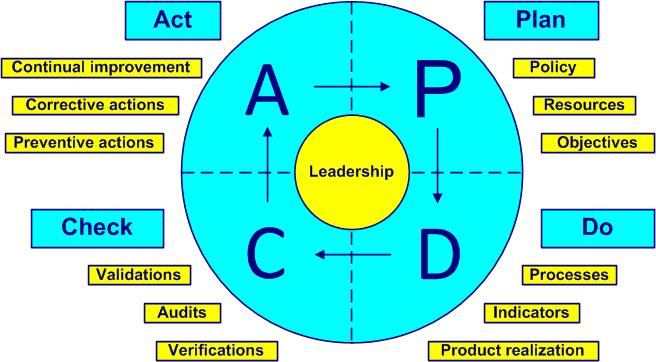1 Quality approach
1.1 History
The word quality, quality department history
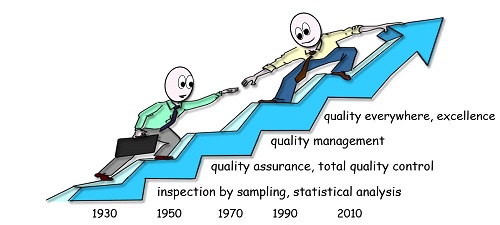
Quality comes from the Latin word qualitas, "way of being", itself derived from the adjective qualis, "as it is".
There are many definitions of the word quality. Some examples:
- state, disposition - Aristotle
- property, attribute - René Descartes
- compliance with requirements - Philip Crosby
- anything that can be improved - Masaaki Imai
- fitness for use - Joseph Juran
- ability to satisfy the customer - Kaoru Ishikawa
- degree to which a set of inherent characteristics of an object fulfils requirements - ISO 9000: 2005, § 3.6.2 (in other words: the ability of a product or service to meet needs)
- absence of defects - Joseph Juran
- seeking the satisfaction of all parties involved in a transaction - Yvon Mougin
- level of excellence
- take pride in your work (work well done)
- do it right the first time and all the time
- it is when the customer likes the product and the employee likes to make the product
- it is when the customer comes back and not the product
The Petit Robert alone gives us six different meanings for the word quality.
Our choice:
Quality: aptitude to fulfill requirements
Everyone makes quality, like Monsieur Jourdain made prose.
Everyone has a point of view on quality, often personal and interesting.
No one is against quality and in principle everyone accepts that:
Quality is a journey, not a destination
In the code of King Hammurabi of Babylon (1730 BCE), we find one of the oldest written traces of quality requirements:
- if an architect builds a house and one of the walls falls, this architect will consolidate this wall at his own expense
- if an architect builds a house and the house collapses and the master of the house is killed, that architect is liable to death
For centuries, quality was intrinsic to all craftsmanship (facilitated by direct contact with the customeranyone who receives a product (see also ISO 9000, 3.3.5)).
With the advent of industrialization (mass production) appeared the division of labor (design, production and inspection) and the interchangeability of parts (beginning of standardization).
In 1924, for the first time, a "quality assurance" department was created in the Bell Telephone company to better satisfy the end customeranyone who receives a product (see also ISO 9000, 3.3.5). At that time in this company, people who would become world-renowned thought leaders such as Shewhart, Deming and Juran worked on and developed the “statistical quality control” approach.
In the 1930s, excesses were reached. For example, in the same Bell Telephone company, it was noticed at one point that the inspection staff was more numerous than the workers!
Until the early 1940s, the inspection department (often called control) had the mission of verifying the conformity of finished productsany outcome of a process or activity (see also ISO 9000, 3.4.2). It was expensive (lots of checks) and not very efficient (defects were discovered at the end of the production cycle).
During the Second World War it was realized that poor quality could be very expensive – a direct link to human lives. Use of inspection at all stages of production began and certain requirementsexplicit or implicit need or expectation (see also ISO 9000, 3.1.2) became mandatory (including reception). A finished production with a lot fewer defects was obtained (they were discovered quite early).
The first American military standards for inspection by sampling were put in place.
In 1949, the American Society for Quality Control (ASQC) was created.
The 1960s and 1970s saw the appearance of quality department, continual improvementpermanent process allowing the improvement of the global performance of the organization (see also ISO 9000, 3.2.13 and ISO 14 001, 3.2), prevention, the daily use of statistics in production, the involvement of all personnel and team spirit for quality. Many approaches and various tools emerged (see chapter 9 of this module).
The first international standards related to quality (ISO 9000 family) appeared in 1987. We talk about quality assurance, zero defects, prevention, corrective and preventive actions and supplier quality assurance (SQA).
During the 1990s, the quality systemset of interacting processes (see also ISO 9000, 3.2.1) encompassed all departments, the notion of total quality and excellence appeared, cf. figure 1-1.
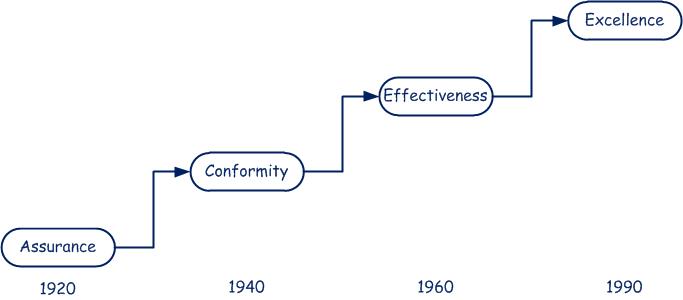
Figure 1-1. History of the quality department
Since the 2000 version of the ISO 9001 standard, quality assurance has been replaced by quality management, the structure has been simplified, the mandatory procedures have reduced. Customer satisfactiontop priority objective of every quality management system (see also ISO 9000, 3.1.4), the process approachmanagement by the processes to better satisfy customers, improve the effectiveness of all processes and increase global efficiency (see also ISO 9004, Annexe B.5), efficiency and continual improvementpermanent process allowing the improvement of the global performance of the organization (see also ISO 9000, 3.2.13 and ISO 14 001, 3.2) become priorities.
The future of quality department is summed up in its purpose: to permanently reduce the gap between the expected quality and the quality perceived by the customeranyone who receives a product (see also ISO 9000, 3.3.5) or, in other words, to help create added value for the customeranyone who receives a product (see also ISO 9000, 3.3.5).
1.2 Principles
The seven quality management principles, PDCA cycle
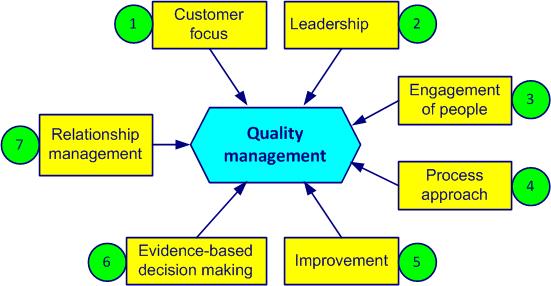
1.2.1 Management principles
The quality approach is a state of mind that starts with top management as a priority strategic decision and extends to all staff. Top management defines the quality policy, in which the quality objectives are set and applicable to all activities. The tool used to achieve the objectives is the quality management systemset of processes allowing the achievement of the quality objectives (see also ISO 9000, 3.2.3). The concept of prevention is generalized.
The purpose of a management system (MS) is to increase customer satisfactiontop priority objective of every quality management system (see also ISO 9000, 3.1.4) (external and internal) by meeting their needs and expectations by continually improving processactivities which transform inputs into outputs (see also ISO 9000, 3.4.1) efficiency.
Quality costs almost nothing when customers are satisfied: they remain loyal to us. It is only when the customeranyone who receives a product (see also ISO 9000, 3.3.5) is not completely satisfied that quality becomes very expensive for us: sooner or later, the customeranyone who receives a product (see also ISO 9000, 3.3.5) goes to a competitor.
Quality remains long after the price has been forgotten
The seven principles of quality management (see figure 1-2) will help us achieve sustainable performance (see ISO 9001: 2015, § 0.2)
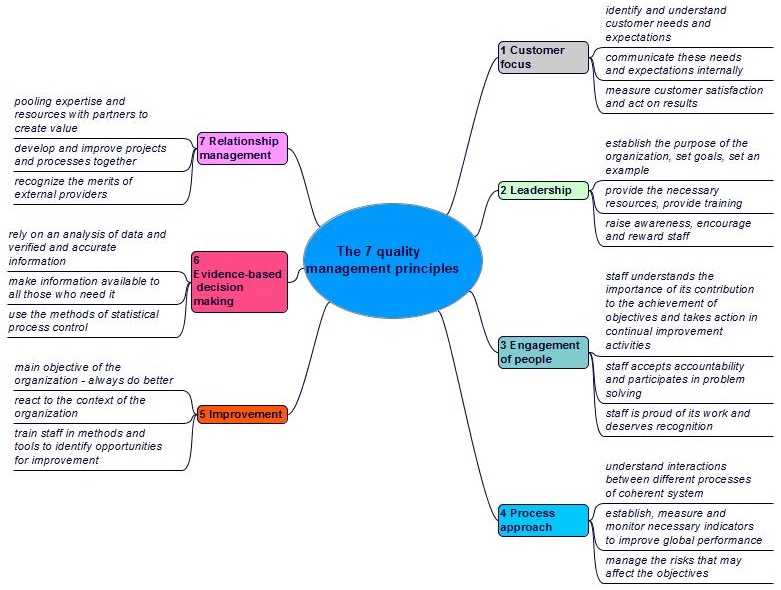
Figure 1-2. The cost iceberg
1.2.2 PDCA cycle
The PDCA cycle, also called Deming cycle, applies to the control of any processactivities which transform inputs into outputs (see also ISO 9000, 3.4.1). PDCA (Plan, Do, Check, Act) cycles are a universal basis for continual improvementpermanent process allowing the improvement of the global performance of the organization (see also ISO 9000, 3.2.13 and ISO 14 001, 3.2) (see figure 1-3).
- Plan – define and establish strategy, customers, policy, resources, objectives, documentation, products, processes, training, deadlines
- Do – organize, implement processes, indicators, produce the product
- Check – compare, inspect, analyze data, verify if objectives are met, validate, audit, learn
- Act – improve, react with actions and find new improvements (new PDCA)

